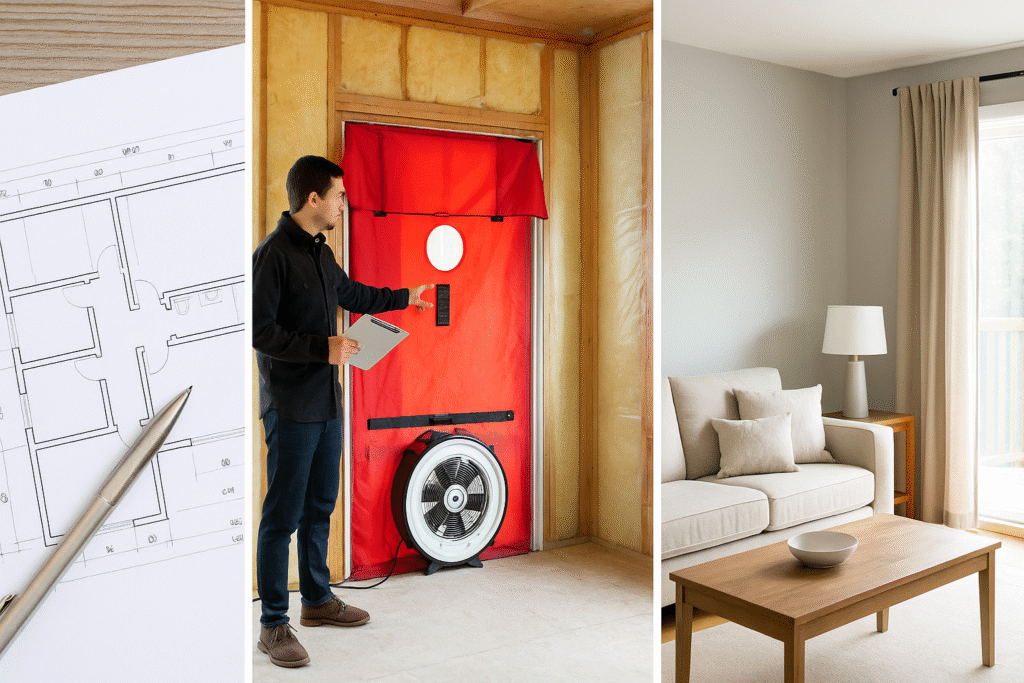
Understanding How Pre-Construction, Mid-Construction, and As-Built Testing Work as part of the BC Energy Step Code Process
You asked:
“The city says I need a BC Energy Step Code Compliance Report from an Energy Advisor before I can get my building permit, this is the last thing I need — what does this process look like and how does it work?”
We get this one a lot from homeowners planning a new build or major renovation for the first time.
Let’s break it down.
Step 1: Pre-Construction Modeling & Compliance Checklist
This is where your project’s energy performance plan begins. For information on our pricing – see our Blog Post on this.
Your Energy Advisor creates a digital energy model of your proposed design using NRCan-approved software. We enter details like:
- Perimeter, area and volumes of all home components
- Wall, ceiling, and floor insulation levels
- Window performance (U-values and SHGC)
- Heating, cooling, and ventilation systems
- Hot water heating system
- Air tightness target (your “blower door” goal) – 2.5 air changes per hour if going for Step 3 (required), 1.5 air changes per hour if going for Step 4 ($15,000 rebate available), 1.0 air changes per hour if going for Step 5 ($20,000 rebate available)
Once the model is complete, you’ll receive your Pre-Construction Compliance Report and Checklist — these are required for your building permit submission.
If the project, as planned, isn’t already meeting Step Code requirements, then we start to look at the most cost-effective and preferred options (by you and your builder) for improving the efficiency to meet the targets.
At this stage, we can also explore “what-if” options. For example:
- What happens if you upgrade to triple-pane windows?
- How much energy could you save by improving attic insulation? Would that small change get us to Step 4 so we are eligible for rebate funding?
It’s the perfect time to make design tweaks that improve performance and unlock rebate funding before construction starts.
Step 2: Mid-Construction Blower Door Testing & Compliance Checklist
Once the home is framed, insulated and the air barrier is in place — but before drywall — we perform a blower door test. For pricing on this step, see our Blog Post.
This test measures how airtight your home actually is at that stage.
Think of it as a “checkup” halfway through the build:
- We set up a calibrated fan in a doorway to gently depressurize the home.
- The fan measures how much air leaks through cracks, penetrations, and gaps.
- We use diagnostic tools (and sometimes smoke pencils or thermal imaging) to find the leaks.
Then, we provide feedback right on site, so your builder or insulator can seal up problem areas before starting drywall installation.
We update the energy model with your real-world results and issue an updated Mid-Construction Compliance Checklist.
This keeps you on track toward your Step Code target and ensures there are no surprises later. Mid-construction blower door testing is optional in some municipalities but we always highly recommend it. If air tightness targets aren’t reached at the As-Built stage, air sealing is much harder and more expensive to accomplish once the air barrier is covered up with drywall and finishes.
Step 3: As-Built Testing, Modeling & Compliance Checklist
Once construction is complete and all systems are installed, we return for the final blower door test and verification. Want to know what we charge for this most often? See our Blog Post.
At this point, we:
- Verify insulation, windows, and HVAC match the design specs.
- Perform the final airtightness test.
- Update the energy model with “as-built” details.
From there, we produce the official As-Built Compliance Report and Checklist — which you’ll need for occupancy.
But that’s not all.
For homes built under the EnerGuide framework, you’ll also receive:
- Your EnerGuide Label, showing the home’s rated energy performance.
- A Homeowner Information Sheet summarizing the major components of your build and energy efficiency level.
These documents aren’t just paperwork – they become a part of your home’s efficiency record, useful for resale value and future upgrades.
So, What’s the Big Picture?
The BC Energy Step Code process might sound technical, but it’s really a structured way to verify that your home performs as designed and meets Energy Step Code Efficiency Requirements.
Here’s a quick summary:
| Stage | Purpose | Deliverables |
| Pre-Construction | Model energy performance before building | Pre-Construction Compliance Checklist |
| Mid-Construction | Verify airtightness and construction components | Mid-Construction Compliance Checklist |
| As-Built | Confirm final performance and assembly details | As-Built Compliance Checklist + EnerGuide Label + Homeowner Information Sheet |
Working with a Registered Energy Advisor ensures that your new home meets BC’s energy performance targets — and that you have clear documentation every step of the way.
Why It Matters
The Step Code process isn’t just about passing a test. It’s about:
- Building a more comfortable, durable home
- Reducing long-term energy costs
- Accessing rebates or financing programs that require verified testing
- Reducing the over-consumption of energy by Canada’s housing stock by building better
If you’re planning a new build and haven’t been through the process before, email, text or call us with your questions. We’re here to make this process straightforward and easy for everyone.
For BC Government information on BC Energy Step Code – see here.
Email: brett@thriveenergyinc.com
Website: www.thriveenergyinc.com


